Essential Arts: Sculptures of grand, vivifying ambition

- Share via
I’m Times art critic Christopher Knight, filling in for regular newsletter emcee Carolina Miranda. She’s off this week driving around the city to round up as many donuts as she can find in anticipation of stuffing down despair when her favorite movies are snubbed for Oscars on Sunday night.
Healthier would be a dynamic, uplifting art gallery visit — like this one:
Big, indescribably eccentric constructions
Phyllida Barlow wrote a prose poem in conjunction with her remarkable show of new sculpture, which was not only made for Hauser & Wirth gallery but also made in it: The colossal works were constructed from the ground up inside the long, tall, skylighted South Gallery. They inhabit the big, elegant room like pushy, boisterous guests.
Make the most of L.A.
Get our guide to events and happenings in the SoCal arts scene. In your inbox every Monday and Friday morning.
You may occasionally receive promotional content from the Los Angeles Times.
In the text she recalls a place from her childhood. It was a place of play, albeit not the sort of safe environment of a neighborhood park, where helicopter parents hover close by and civic agencies have dutifully followed rules of harmless design for friendly chutes and ladders, partly out of diligent care for youthful life and limb and partly out of reasonable fear of liability lawsuits.
Instead, Barlow conjures a gauzy memory, a vague recollection of a ghastly yet wonderful industrial ruin — a “circle of rusted railings, decrepit, close to collapse, ominous.” This “broken construction” happily provided for her and her exploratory kid-pals “threats of danger,” plus wild opportunities to burrow in “somewhere unknown to the rest of the world.”
So, that’s what she has filled the gallery with — big, rough-and-tumble, indescribably eccentric constructions.
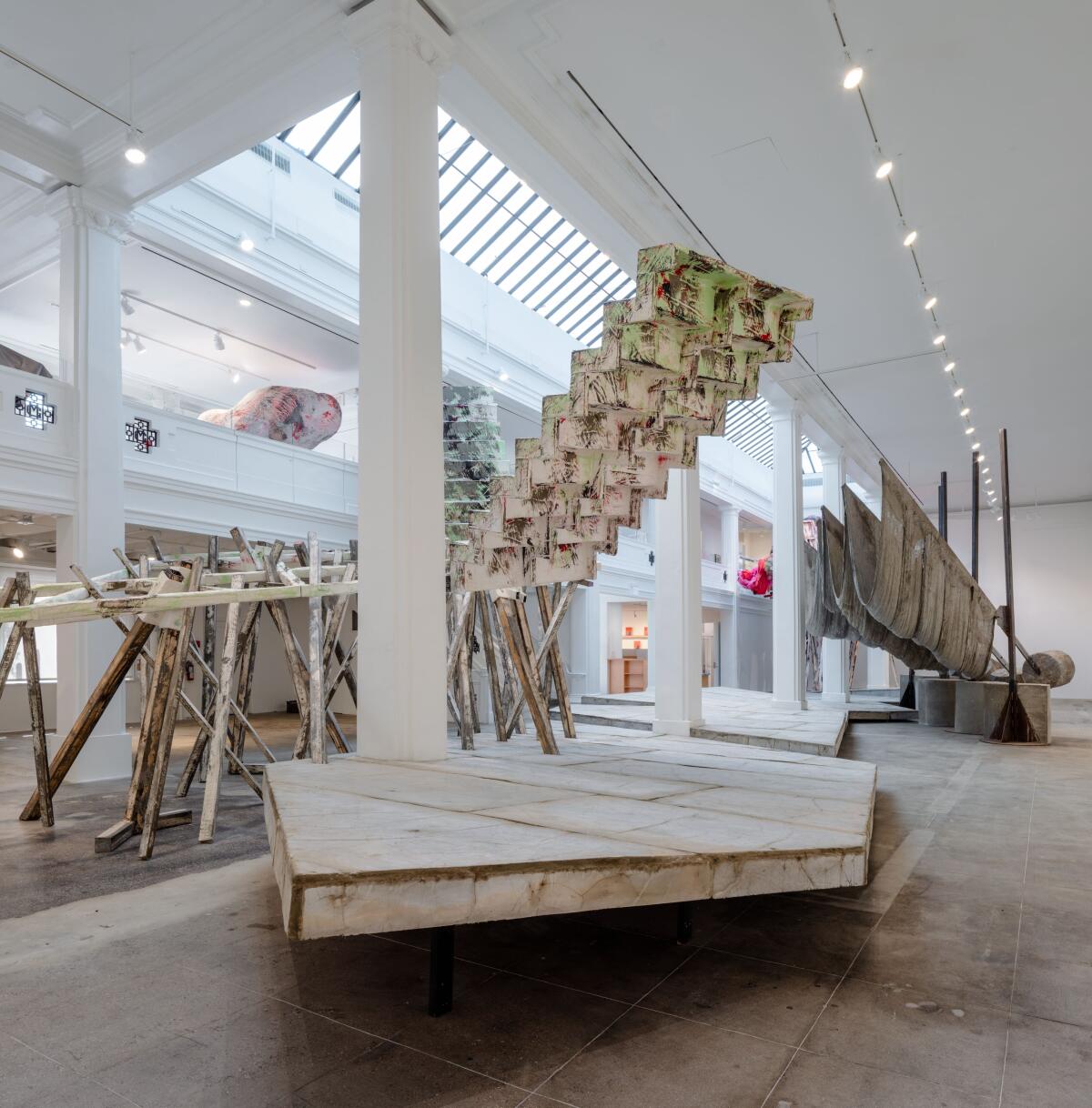
The objects, many smeared with chalky white plaster or heavy gray cement, a few streaked with reddish pink paint as if a stylish bleed, glance by such recognizable things as rickety staircases leading up to an attic or down to a dungeon. Others imply mechanized winches, sagging nets suspended on fishing trawlers down at the seaport, counterweights that allow oil derricks to pump away and bandaged hospital splints.
Up on the room’s mezzanine, blocky, cowled forms suggesting monks lashed together with rubber cord lurk silently, as if in an obscure horror story. Peer into their forbidding black hoods and gaily stitched pieces of hot-pink woolen felt inside invite unexpected visual caresses.
The forms of Barlow’s sculptures are none of and all these things, but mostly they are catapults for imaginative engagement. And they nod in the direction of other artists.
Organic lumps hoisted up on pedestals are like Barbara Hepworth sculptures impossibly inflated with air, then mated with a William Turnbull monolith gone droopy. The tangled, ceiling-high forest of sticks holding bundles of bleached or stained cloth aloft is like the great, irregular grids of tree limbs or stakes bound together at the joints with yards of twine or copper wire by sculptor Jackie Winsor — and then promptly exploded with powerful dynamite.
The most mesmerizingly outlandish is a cantilevered pair of stairs, splayed out in a huge V-formation.
One stair rises to the mezzanine, as if a plant yearning for the sunlight streaming through the skylight, 21 feet overhead, while the other slips beneath the lowered ceiling opposite. Crusted with white plaster and paint, the constructions defy the delicacy found in any Cy Twombly assemblage of dirty-white, cast-off boxes and sticks. Together these precariously balanced stairways to heaven are like the wings of some giant, lumbering, prehistoric bird struggling to launch from the off-kilter theatrical stage Barlow has built to wrap around the gallery’s sturdy Neoclassical columns.
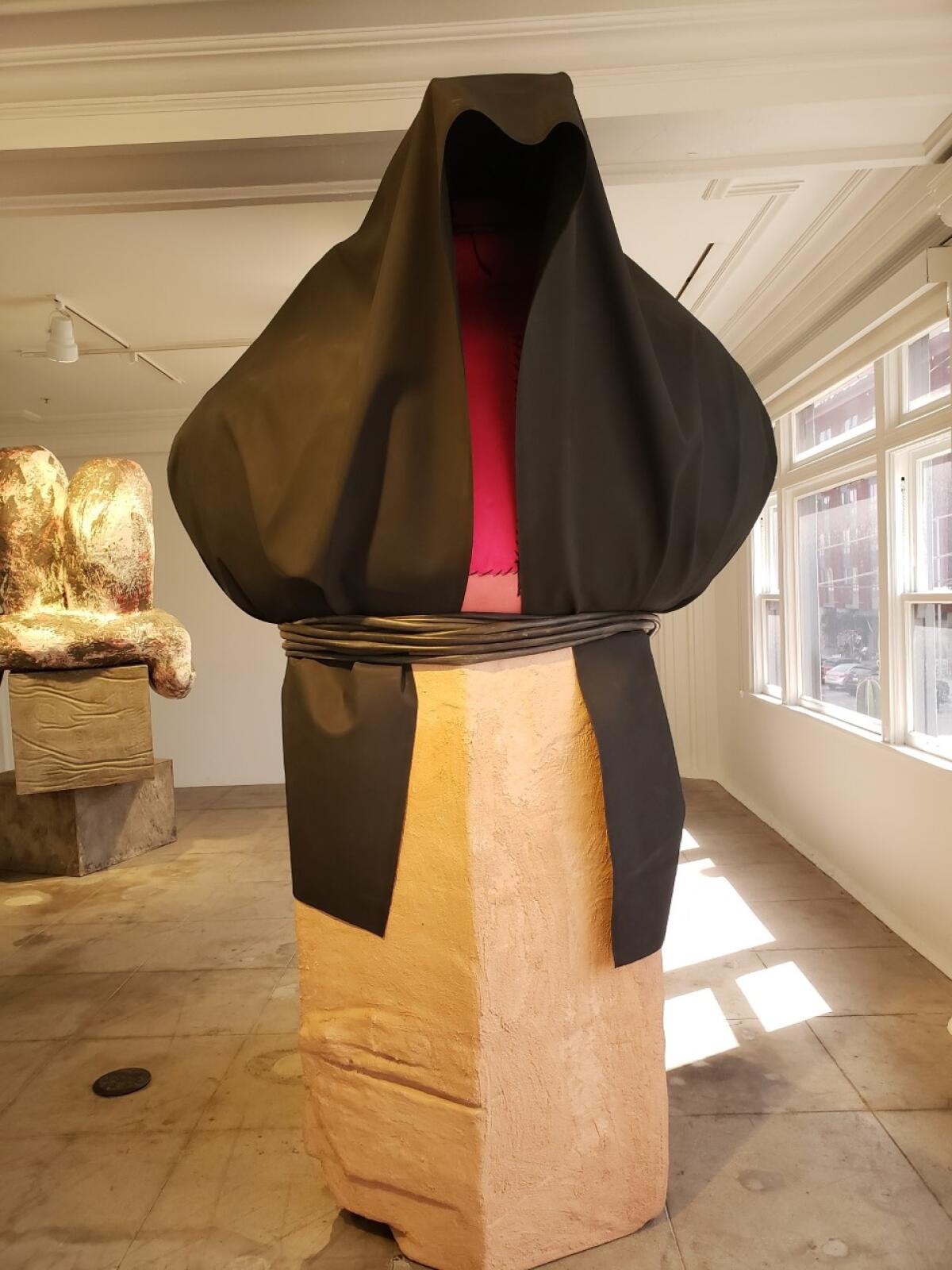
You’ve never seen anything quite like it — or maybe you have, which is part of their charm. Barlow pulls from a variety of established artistic forms, mixes them with her own peculiar sense of invention, then seems to drop them into an industrial-strength blender to produce sculptures of grand, vivifying ambition. She titled her exhibition (and her poem) “glimpse,” and that’s what you get — a partial perception, a spur to wonderment, yet both pumped up on an epic scale.
Barlow, 77, was born in Newcastle upon Tyne, an industrial port in the north of England, in the waning year of World War II, and she was raised in crumbled London, then limping back from a traumatic era of brutal devastation. Glimpses of both are embedded inside her bracing work, along with a healthy dose of stupefaction and bewilderment. All that seems exactly right for where we are now.
The show is at Hauser & Wirth, 901 E. 3rd St., through May 8.
Enjoying this newsletter? Consider subscribing to the Los Angeles Times
Your support helps us deliver the news that matters most. Become a subscriber.
On and off the stage
Holland Taylor has been a Hollywood mainstay for decades, with memorable roles in contemporary shows like “The Chair” and “The Morning Show.” Starting this weekend at Pasadena Playhouse, though, Taylor will be reprising her Broadway role as Texas Gov. Ann Richards in “Ann,” a one-woman play she wrote and stars in. Taylor was driven to honor the late public servant “who was in it for all the right reasons — to make people’s lives better,” she tells theater critic Charles McNulty. But in creating the play, McNulty writes, Taylor “also gave herself something long overdue — a Broadway role commensurate with her gifts.”
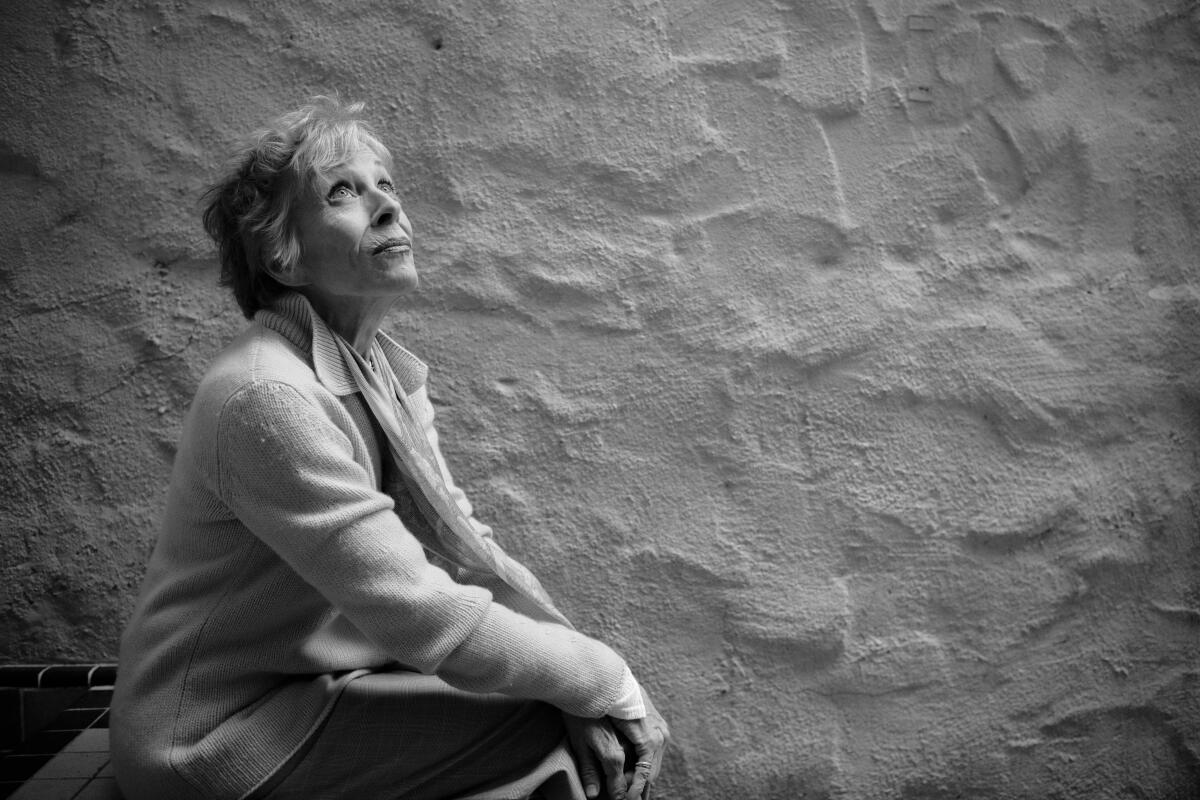
McNulty also has a look at two recent world premieres — Boni B. Alvarez’s “Apartment Living” and Benjamin Benne’s “Alma” — that rethink the tradition of kitchen-sink realism. Both works invite viewers into the “homes of ordinary Angelenos, some with decent jobs, others struggling to get by,” he writes. “Black, Mexican American and Filipino American, they are fighting against the odds for a sliver of the American dream.”
Musical fans, rejoice! The Pantages and Dolby Theatre have announced their lineup for the 2022-23 year — their first full-season announcement in two years, reports Ashley Lee. It includes the likes of musical phenomenon “Six” (about the six wives of Henry VIII) and the jukebox musical about the legendary Tina Turner.
But as in-person theater is returning in full swing after two years of shutdowns, some creatives who had long sustained the industry have opted not to return with it. “There’s the risk that we’re losing a generation of people and their unique skill sets, which is necessary for this sector of the industry to function,” Carson Elrod, co-founder of Arts Workers United, tells Lee. In this photo essay, Lee speaks with 10 artists who, after reflecting on their career choices during the COVID-19 pandemic as well as what they had tolerated for the love of the art form, decided to pivot away from theater.

On the subject of pivots, Makeda Easter profiles the couple behind Artists Who Code, a group that helps artists use their skills to transition from creative fields to tech. The initiative was born out of Catherine Ricafort McCreary and Scott McCreary’s own deep frustrations working as full-time artists and their desire for financial security. “We thought: If your job is gone, there’s never a better time to learn what we did,” Scott says. “We want to make it easier and help people who are hurting.”
Visual arts
The Academy Museum of Motion Pictures had just swung its doors open in 2021 “when people began asking how, in a museum devoted to a diverse and varied examination of filmmaking, the people who created the industry were largely, and alarmingly, absent,” writes culture columnist and critic Mary McNamara. “Especially since most of the industry’s founders were Jewish,” including Samuel Goldwyn, Louis B. Mayer, William Fox, Jack and Harry Warner and Carl Laemmle. Following backlash over the lack of Jewish representation at the museum, the academy has announced “Hollywoodland,” one of eight new exhibits coming to the museum over the next year, which will trace the story of how and why Los Angeles became the center of filmmaking.

The Academy Museum’s neighbor LACMA has just opened a retrospective detailing the 40-year artistic career of Barbara Kruger, who has long probed the social, cultural and political landscape with striking, witty work. The “smashing” show, as I wrote in my review, sees Kruger probing our unusual cultural moment in a way that neither “complains about nor dodges the mass media context, instead unpacking it for us.”
Architecture and urban design columnist Carolina Miranda also profiles the boundary-pushing video artist and art godfather Ulysses Jenkins on the heels of his Hammer Museum retrospective. Over the past half a century, Jenkins’ expansive work has evolved and “grown more artful, more performative, inspired by ritual and ever more surreal — it has continued to document stories that don’t always get told,” Miranda writes. Jenkins likens his art to the storytelling by West African musicians/oral historians known as griots. “The histories and traditions come from the griots,” he says. “They reassert the history and the culture.”
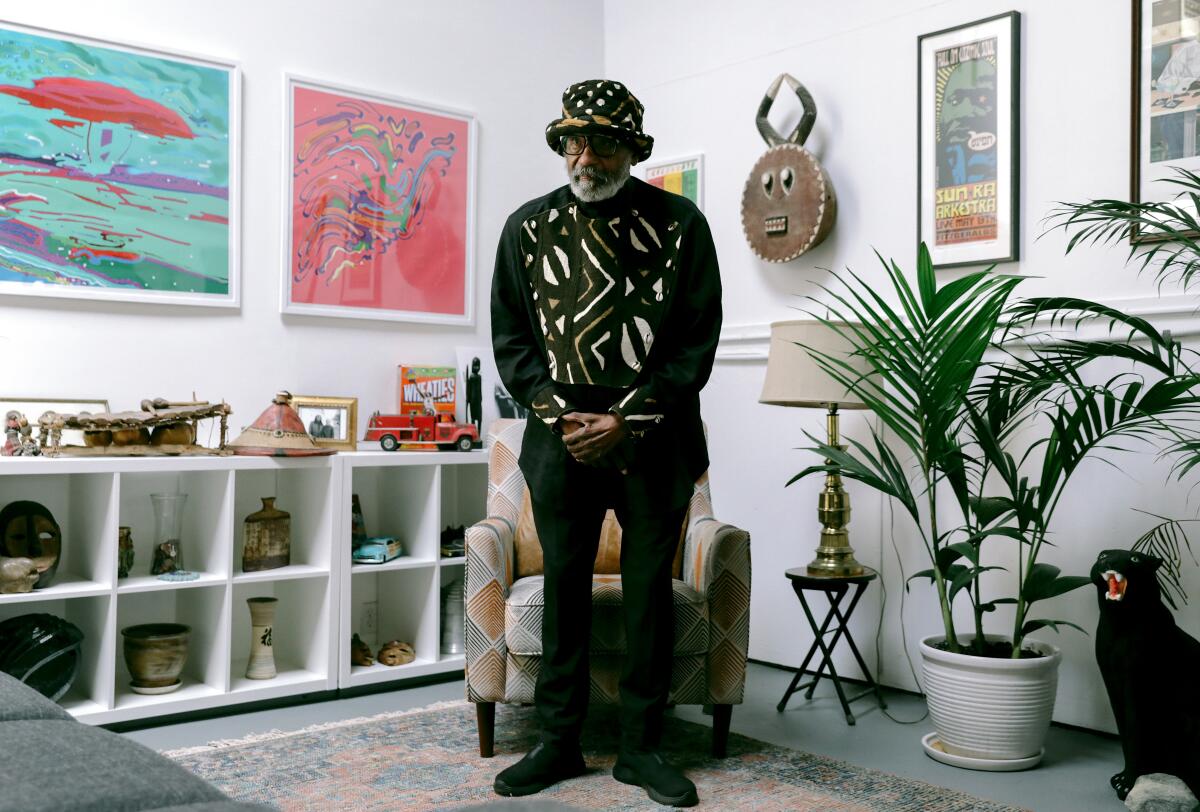
And 18 arts organizations in Los Angeles have received grants from the Mike Kelley Foundation for the Arts, reports Deborah Vankin. “Many arts organizations created online programming during the pandemic, which represents, to me, an incredible amount of creativity,” says foundation Executive Director Mary Clare Stevens. “Now many of them are looking to retain these sorts of hybrid models with both in-person and online programming because they’re reaching broader audiences, but that takes work — and it comes with a cost.” Each organization will receive $10,000 to $30,000 in unrestricted funds for operations and programming to help them stay afloat.
Ukraine and the arts
It’s been another brutal week as Russia continues its invasion of Ukraine. This week, an Art Nouveau museum in the port city of Mariupol dedicated to the work of the 19th century artist Arkhip Kuindzhi was destroyed in an airstrike. Thousands still continue to flee the country — an estimated 3 million Ukrainians have left the region. More than half of those are thought to be children.
Reporter Jessica Gelt spoke with several young dancers who have fled Ukraine with the help of the Youth America Grand Prix, the world’s largest student ballet scholarship competition. The organization, founded by two former dancers for the Bolshoi Ballet, was set to hold its first competition in Kyiv in early March; more than 200 young dancers had signed up to take part from all over Eastern Europe. After the event was canceled amid the war, the organization offered to help place Ukrainian dancers at different ballet schools across Europe. Maximilian Mann photographed the students in their new schools in the likes of Monaco and Amsterdam.
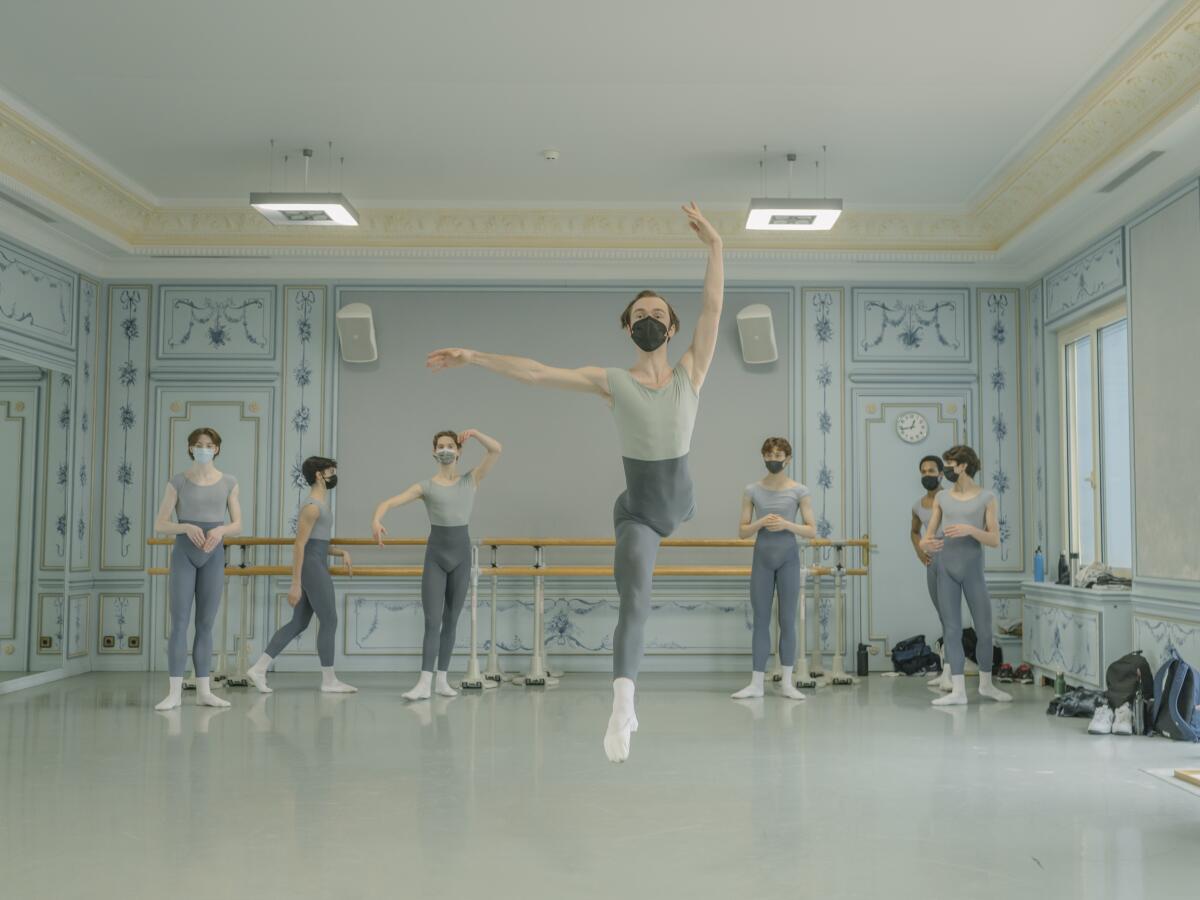
As residents continue to flee the region, the Ernst von Siemens Art Foundation, a Berlin-based organization, has also launched an initiative so that curators who previously worked at museums across Ukraine may work at any German museum.
Classical notes
When jazz pianist Jason Moran begins to play the keys, “resonances overpower the senses,” writes classical music critic Mark Swed. “A single struck note not only sounds grounded but also feels grounded, as though it were coming from under your feet and then filling the space with a sonic aura.” That’s partially why Moran has become a go-to composer for dance performances, most recently Ronald K. Brown’s “The Equality of Night and Day,” Alonzo King’s “Single Eye,” part of American Ballet Theatre’s Segerstrom Hall residency, and the Martha Graham Dance Company’s reimagination of “Canticle for Innocent Comedians.”
Lara Downes, an accomplished pianist who has performed at the likes of Tanglewood and Carnegie Hall, is taking up the mantle as evening host on KUSC-FM (91.5) following Jim Svejda’s retirement from the classical music station. In an interview with The Times, she discusses her interest in both telling stories through music and telling stories about music. “I think a radio show, like an album, needs to create a sound world,” she tells Tom Jacobs. “Each show is an emotional journey with dips and swells.”
This week marks 20 years that Grant Gershon has led the Los Angeles Master Chorale. Over the past two decades, Gershon has transformed the choral group into a boundary-pushing ensemble, writes Jessica Gelt. Gershon “decided to redefine the very idea of a professional choir — what it should be, and what it could be,” says former Los Angeles Philharmonic music director Esa-Pekka Salonen.
Essential happenings
Looking for something to do this weekend? Matt Cooper has you covered. The Ballet Folklórico de México de Amalia Hernández will be performing at the Luckman Fine Arts Complex at Cal State L.A. Meanwhile, A Noise Within will be presenting “Anna in the Tropics,” Nilo Cruz’s Pulitzer Prize-winning 2002 drama about the lives of Cuban immigrants in 1920s Tampa. At Segerstrom Center for the Arts, check out “Nowruz: The Iranian New Year Concert,” a production by Carl St.Clair and Pacific Symphony featuring a program including Vivaldi, Mussorgsky and selections from contemporary Iranian composers.
Passages
Budi Tek, a patron and collector of Chinese art who founded Shanghai’s Yuz Museum, has died at age 65.
Steve Wilhite, who in 1987 invented the file format for what would become GIFs, died as a result of COVID-19 complications.
In other news
• “CODA,” a serious contender for best picture at this weekend’s Oscars, will be developed into a stage musical by Deaf West, an L.A.-based nonprofit committed to producing “Deaf-centered storytelling.”
• This weekend, the Baltimore Museum of Art will open a show, “Guarding the Art,” with works curated by 17 members of the institution’s security team.
• Later this spring, Christie’s will be selling an Andy Warhol silkscreen of Marilyn Monroe for roughly $200 million — which would be the highest price a 20th century artwork has ever gone for at auction.
• Antiquities expert Dr. Christos Tsirogiannis is asking the Getty Museum to repatriate an ancient Roman fresco fragment, which, according to Tsirogiannis, has been linked to an art dealer accused of hawking looted artworks.
• The Memphis Airport removed artist Tommy Kha’s self-portrait of himself dressed in a sparkling Elvis suit from the airport earlier this month; following backlash and accusations of censorship, Kha’s work has been reinstalled.
And last but not least...
In yet another example of how the internet and real life are becoming indiscernible, the meme “Is it cake?” — where ordinary objects are placed side by side with an object that is, in fact, cake — is now the premise of a Netflix show of the same name. If you find the prospect of cutting into a shoe, a Solo cup or a purse oddly mesmerizing, there’s a trailer full of objects-as-cake waiting for you.
The biggest entertainment stories
Get our big stories about Hollywood, film, television, music, arts, culture and more right in your inbox as soon as they publish.
You may occasionally receive promotional content from the Los Angeles Times.




